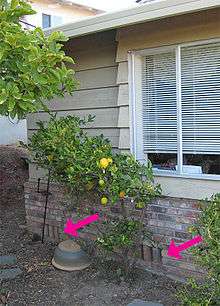Crawl space vent


A crawl space vent is a penetration in the wall of a building which allows air to circulate from the crawl space beneath the building to the exterior.
General
Dry rot and other conditions detrimental to buildings (particularly wood and timber structures) can develop in enclosed spaces. Providing adequate ventilation is thought to reduce the occurrence of these problems. Crawl space vents are openings in the wall which allow air movement. Such vents are usually fitted with metal grating, mesh, or louvers which can block the movement of rodents and vermin but generally not insects such as termites and carpenter ants. One common rule is to provide vents in cross sectional area equal to 1/150 of the floor area served.[1]
Modern crawl space thinking has reconsidered the usage of crawl space vents in the home.[2][3] While crawl space vents do allow outside air to ventilate into the home, the ability of that air to dry out the crawl space is debatable.[4] In areas with humid summers, during the summer months, the air vented into a crawl space will be humid, and as it enters the crawl space, which has been cooled naturally by the earth, the relative humidity of the air will rise. In those cases, crawl space vents can even increase the humidity level of a crawl space and lead to condensation on cool surfaces within, such as metal and wood.[5] In the winter, crawl space vents should be shut off entirely, to keep out the cold winter air which can cool hot water pipes, furnaces, and water heaters stored within. During rainy weather, crawl space vents bring wet air into the crawl space, which will not dry the space effectively.
Crawl space vents also contribute to the "stack effect", a phenomenon by which warm air rises in the home and exits from the upper levels.[2] This creates a vacuum in the lower levels and can pull crawl space air upwards into the home. By sealing off all openings in the crawl space, including the vents, unconditioned outside air is kept out of the home.
References
- ↑ 2003 International Building Code, Section 1203.3, International Code Council
- 1 2 "To Vent or Not to Vent" (pdf). advancedenergy.org. Retrieved 2009-07-03.
- ↑ "Crawl Space Insulation". US Dept. of Energy. Retrieved 2009-07-03.
- ↑ "Closed crawl spaces do double duty" (pdf). advancedenergy.org. Retrieved 2009-07-03.
- ↑ "Closing the crawl" (pdf). Builder magazine Oct 2005 (reproduced by advancedenergy.org). Retrieved 2009-07-03.